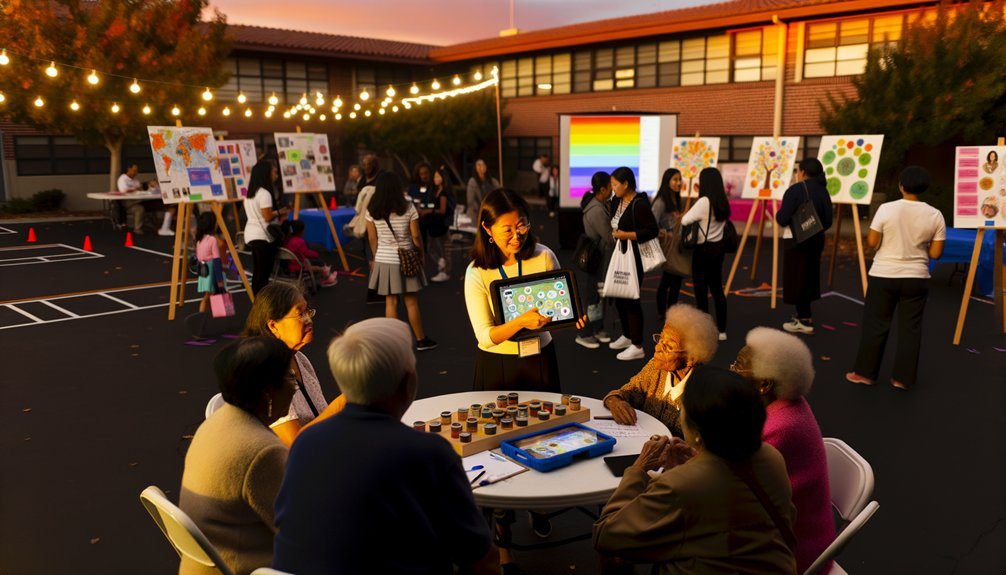Share your findings via open data portals with clear metadata and example code so others can access, reuse, and cite your work. Host live events or real-time broadcasts to demonstrate methods, answer questions, and build trust with visuals and short segments. Partner with schools, libraries, and community groups to co-create practical, hands-on programs and toolkits that make results usable. Each approach boosts reach, transparency, and impact — keep going to see how to apply them step by step.
Key Takeaways
- Publish data and code on open science portals with clear metadata, DOIs, and example scripts for reuse.
- Host live events or webcasts with visuals, Q&A, and follow-up resources to explain findings in real time.
- Partner with schools, libraries, and community groups to co-create accessible, locally relevant materials and activities.
- Produce concise plain-language summaries, infographics, and short videos tailored to target audiences and platforms.
- Solicit feedback, share credit, and track outcomes to refine messaging and sustain community engagement.
Public Data Releases and Open Science Portals

When you want your work to have maximum reach and reuse, public data releases and open science portals make it easy for others to find, understand, and build on your datasets; they provide standardized formats, metadata, and access controls that turn raw files into shareable resources. You’ll increase data accessibility by choosing platforms that index datasets, assign persistent identifiers, and expose clear licensing terms so others know how they can reuse your work. You should include thorough metadata, readme files, and example code to lower the barrier for reuse and support reproducibility. Open collaboration happens when contributors can propose improvements, submit derived data, or link publications to the portal; enabling versioning and contribution workflows helps maintain quality. Think about discoverability—use controlled vocabularies and tags—and about sustainability—pick repositories with preservation policies. By designing your release for easy uptake, you’ll make your findings more impactful, citable, and ready for integration into new analyses and applications.
Live Events and Real-Time Broadcasts
Public data portals make your results easy to find later, but live events and real-time broadcasts let you engage audiences as research is happening and shape immediate understanding and response. You can host live demonstrations to show methods, pitfalls, and results in action, which builds trust by demystifying processes. Real-time streams let you narrate decisions, field questions, and correct misunderstandings on the spot, so viewers follow your reasoning rather than guessing outcomes.
Plan short segments, captioning, and clear visuals so people can join at any time and still grasp key points. Use interactive workshops during or after broadcasts to let participants try tools, probe data, and practice interpretation—this deepens learning without requiring formal partnerships. Prepare moderators to manage Q&A and record sessions for later access. Finally, set expectations about data limitations and follow-up resources so your live engagement complements, rather than replaces, thorough documentation and archived releases.
Educational Outreach and Community Partnerships

How can you turn your findings into learning experiences that last? You’ll build trust by designing community workshops that translate results into practical skills and local actions. Partner with schools, libraries, and nonprofits so your content meets real needs. Use collaborative projects to invite co-creation: participants help shape methods, which boosts relevance and retention. Offer hands-on demos, simple visuals, and take-home materials so people apply insights later. Track outcomes with short surveys and follow-up meetups to refine your approach.
| Activity | Benefit |
|---|---|
| School modules | Reach families early |
| Library talks | Accessible, low-cost venues |
| Co-research events | Empower participants |
| Toolkits | Support continued use |
Keep sessions concise, use plain language, and respect community knowledge. You’ll increase impact by listening, adapting, and sharing credit. Educational outreach isn’t one-way: it’s a partnership that turns findings into sustained community value.
Frequently Asked Questions
How Do I Measure the Public Impact of My Findings?
Jump right in: you measure public impact by combining quantitative metrics and qualitative insights. Track reach, behavior change, citations, policy mentions, and public feedback through surveys, analytics, and interviews. Use an impact assessment framework to set goals, choose indicators, collect baseline data, and monitor over time. Triangulate sources to validate findings, report transparently, and iterate—after all, Rome wasn’t built in a day—so refine methods as you learn what truly moves people.
What Are Best Practices for Handling Sensitive or Proprietary Data?
You should minimize risk by using data anonymization techniques, strict access controls, and clear governance policies. Mask or aggregate identifiers, apply differential privacy where appropriate, and keep proprietary details on need-to-know bases. Establish data use agreements, audits, and secure storage; document ethical data sharing practices and consent processes. Train your team on compliance and incident response, and review sharing plans with legal and stakeholders to balance transparency and protection.
How Can I Tailor Communication for Non-English Speaking Audiences?
You should tailor communication by using simple language, translated materials, and culturally relevant examples. Use visual aids like infographics and videos to bridge language gaps, and test translations with native speakers. Build community partnerships with local organizations and translators to guarantee accuracy and trust, and offer multiple formats (audio, print, social). Monitor feedback, adapt messaging, and prioritize clarity so your content’s accessible, respectful, and useful to diverse audiences.
What Legal or Ethical Approvals Are Typically Required for Public Sharing?
Think of approvals like a traffic light guiding your release: you’ll usually need institutional review board sign-off, informed consent documentation where participants are identifiable, and adherence to ethical guidelines and data protection laws (like GDPR). You may also need permissions for third-party content, privacy impact assessments, and sometimes legal review for sensitive or proprietary findings. Always document approvals and follow reporting requirements so you’re transparent and accountable.
How Do I Fund Long-Term Public Engagement and Dissemination?
You fund long-term public engagement by diversifying income: pursue grant opportunities from foundations and government programs, run recurring crowdfunding campaigns for community support, and build institutional partnerships that provide steady backing. You’ll also monetize sustainably via memberships, paid workshops, or licensing, while documenting impact to strengthen future proposals. Keep a mixed revenue model so one stream’s fluctuation won’t derail your outreach, and reinvest earned funds into engagement capacity.